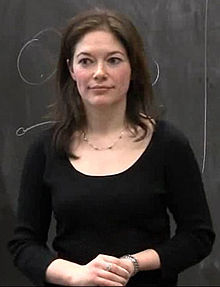Maria Chudnovsky
Maria Chudnovsky | |
|---|---|
 Chudnovsky in 2011. | |
| Born | January 6, 1977 Leningrad, Soviet Union[1] |
| Nationality | Israeli-American |
| Alma mater | Technion Princeton University |
| Known for | Graph theory, Combinatorial optimization |
| Scientific career | |
| Fields | Mathematics |
| Institutions | Princeton University |
| Thesis | Berge Trigraphs and Their Applications. (2005) |
| Doctoral advisor | Paul Seymour |
Maria Chudnovsky (born January 6, 1977) is an Israeli-American mathematician working on graph theory and combinatorial optimization.[2] She is a 2012 MacArthur Fellow.[3]
Education and career[]
Chudnovsky is a professor in the department of mathematics at Princeton University. She grew up in Russia (attended Saint Petersburg Lyceum 30) and Israel, studying at the Technion,[4] and received her Ph.D. in 2003 from Princeton University under the supervision of Paul Seymour.[5] After postdoctoral research at the Clay Mathematics Institute,[4] she became an assistant professor at Princeton University in 2005, and moved to Columbia University in 2006. By 2014, she was the Liu Family Professor of Industrial Engineering and Operations Research at Columbia. She returned to Princeton as a professor of mathematics in 2015.[2]
Research[]
| External video | |
|---|---|
Chudnovsky's contributions to graph theory include the proof of the strong perfect graph theorem (with Neil Robertson, Paul Seymour, and Robin Thomas) characterizing perfect graphs as being exactly the graphs with no odd induced cycles of length at least 5 or their complements.[7][8][9] Other research contributions of Chudnovsky include co-authorship of the first polynomial-time algorithm for recognizing perfect graphs (time bounded by a polynomial of degree 9),[10] and of a structural characterization of the claw-free graphs.[11]
Selected publications[]
- Chudnovsky, Maria; Cornuéjols, Gérard; Liu, Xinming; Seymour, Paul; Vušković, Kristina (2005), "Recognizing Berge graphs", Combinatorica, 25 (2): 143–186, doi:10.1007/s00493-005-0012-8, MR 2127609, S2CID 2229369.
- Chudnovsky, Maria; Seymour, Paul (2005), "The structure of claw-free graphs", Surveys in Combinatorics 2005, London Mathematical Society Lecture Note Series, 327, Cambridge: Cambridge Univ. Press, pp. 153–171, CiteSeerX 10.1.1.112.4130, doi:10.1017/CBO9780511734885.008, ISBN 9780511734885, MR 2187738.
- Chudnovsky, Maria; Robertson, Neil; Seymour, Paul; Thomas, Robin (2006), "The strong perfect graph theorem", Annals of Mathematics, 164 (1): 51–229, arXiv:math/0212070, doi:10.4007/annals.2006.164.51, S2CID 119151552.
- Chudnovsky, Maria; Sivaraman, Vaidy (2018), "Odd Holes in Bull-Free Graphs", SIAM Journal on Discrete Mathematics, 32 (2): 951–955, arXiv:1704.04262, doi:10.1137/17M1131301, MR 3794342, S2CID 1657094
Awards and honors[]
In 2004 Chudnovsky was named one of the "Brilliant 10" by Popular Science magazine.[12] Her work on the strong perfect graph theorem won for her and her co-authors the 2009 Fulkerson Prize.[13] In 2012 she was awarded a "genius award" under the MacArthur Fellows Program.[14][15]
Personal life[]
She is a citizen of Israel and a permanent resident of the USA.[2]
In 2012, she married Daniel Panner, a viola player who teaches at Mannes School of Music and the Juilliard School. They have a son named Rafael.[16]
References[]
- ^ Interview with a Mathematician
- ^ Jump up to: a b c "Maria Chudnovsky Curriculum Vitae" (PDF). Princeton University. Retrieved 25 May 2015.
- ^ "2012 MacArthur Foundation 'Genius Grant' Winners". 1 October 2012. AP. Retrieved 1 October 2012.
- ^ Jump up to: a b Interview with Research Fellow Maria Chudnovsky (PDF), Clay Mathematics Institute, 2005.
- ^ Maria Chudnovsky at the Mathematics Genealogy Project
- ^ "Maria Chudnovsky". MacArthur Fellows Program. MacArthur Foundation. October 2, 2012. Retrieved December 13, 2014.
- ^ Mackenzie, Dana (July 5, 2002), "Mathematics: Graph theory uncovers the roots of perfection", Science, 297 (5578): 38, doi:10.1126/science.297.5578.38, PMID 12098683, S2CID 116891342.
- ^ Cornuéjols, Gérard (2002), "The strong perfect graph conjecture", Proceedings of the International Congress of Mathematicians, Vol. III (Beijing, 2002) (PDF), Beijing: Higher Ed. Press, pp. 547–559, MR 1957560, archived from the original (PDF) on 2014-04-07, retrieved 2012-08-11.
- ^ Roussel, Florian; Rusu, Irena; Thuillier, Henri (2009), "The strong perfect graph conjecture: 40 years of attempts, and its resolution", Discrete Mathematics, 309 (20): 6092–6113, doi:10.1016/j.disc.2009.05.024, MR 2552645.
- ^ Chudnovsky et al. (2005).
- ^ Chudnovsky & Seymour (2005).
- ^ Minkel, J. R. (June 29, 2004), "Maria Chudnovsky", Popular Science
- ^ "2009 Fulkerson Prizes" (PDF), Notices of the American Mathematical Society: 1475–1476, December 2011.
- ^ Lee, Felicia R. (October 1, 2012), "Surprise Grants Transforming 23 More Lives", New York Times
- ^ Maria Chudnovsky, MacArthur Foundation, October 2, 2012.
- ^ Cohen, Joyce (2014-01-08). "Striking While the Iron Is Hot - NYTimes.com". The New York Times. Retrieved 2016-02-03.
External links[]
- Living people
- Graph theorists
- Princeton University alumni
- Princeton University faculty
- Columbia University faculty
- Israeli mathematicians
- Women mathematicians
- 1977 births
- MacArthur Fellows
- Combinatorialists